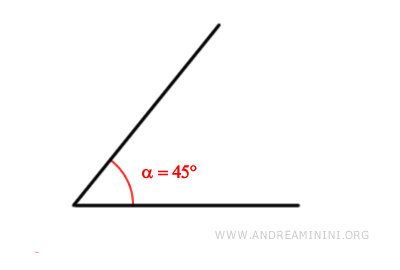Postulate of Angle Divisibility
Any angle α with a non-zero measure can be divided into n>0 congruent parts.
Where n is any natural number.
The n-th part of the angle is a submultiple β of the angle itself.
$$ \beta = \frac{1}{n} \alpha $$
A Practical Example
Let's consider an angle α measuring 45°

We divide the angle into n=3 equal parts.
$$ \beta = \frac{1}{3} \cdot 45° = 15° $$
Each part is an angle β of 15° and is a submultiple of the original angle α.

The sum of the three 15° angles gives us the original angle α (45°)
$$ 15° + 15° + 15° = 45° $$
In the same way, we can divide the angle α into any number of parts.
And so forth.
